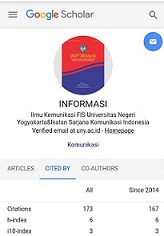The conventional media's political economy practices in the media convergence era: Case study of labor commodification in TV industry
DOI:
https://doi.org/10.21831/informasi.v53i1.57013Keywords:
Media Convergence, Communication Media Industry, Media Political Economy, Labor Commodification, Power RelationsAbstract
Technological developments provide benefits for the society in receiving information and entertainment. This has resulted many innovations made by the communication media industry players, one of which is NET. TV by conducting media convergence. Media convergence is a consequence caused by technological developments, which then affects competition in the media industry. Media convergence is gaining momentum in the communications industry, where digital technology is being used more than conventional one. Under the auspices of PT Net Visi Media, NET. TV has now looked at YouTube and over-the-top digital platforms. By looking at the transitions, this research was conducted with a critical paradigm by mapping the problems that occur related to vertical power relations, based on political economy theory of communication media by Vincent Mosco. Interview with NET. TV production team became the primary data, which was then analyzed descriptively. According to the characteristics coined by Vincent Mosco as an analytical tool, the result is NET. TV performs absolute and relative labor commodification during media convergence. Where the Tonight Show Premiere and Match Island production teams are required to be multitasking and work overtime without being paid.
References
Armando, A. (2016). Televisi Indonesia di bawah kapitalisme global. Buku Kompas.
Baran, S. J., & Davis, D. K. (2010). Teori Komunikasi Massa: Dasar, Pergolakan dan Masa. Salemba Humanika.
Caporaso, J. A., & Levine, D. P. (2012). Theories of political economy. Cambridge University Press
Durham, M. G., & Kellner, D. M. (2009). Media and cultural studies: Keyworks. Wiley-Blackwell.
Dwyer, T. (2010). Media convergence. Open University Press, McGraw-Hill Education (UK).
Fuchs, C, (2014). Digital labor and karl marx. Routledge
Gandy, O. H., Jr. (1997). The political economy approach: A critical challenge. Journal of Media Economics, 5(2), 23–42. https://doi.org/10.1080/08997769209358221
Golding, P., & Murdock, G. (1997). The political economy of the media. Edward Elgar Pub.
Hamdani, T. (2020, Desember 04). Net tv belum lolos dari jurang pailit, ini 3 faktanya. Retrieved from https://finance.detik.com/berita-ekonomi-bisnis/d-5281847/Net-tv-belum-lolos-dari-jurang-pailit-ini-3-faktanya
Haryono, C. G. (2020). Kajian ekonomi politik media: Komodifikasi pekerja dan fetisisme komoditas dalam industri media. CV Jejak (Jejak Publisher).
Haryono, C. G. (2018). Komodifikasi Pekerja Televisi di Indonesia (Studi Ekonomi Politik Media Tentang Praktik Komodifikasi pekerja dalam produksi program siaran televisi di indonesia). Universitas Indonesia.
Hesmondhalgh, D. (2013). The cultural industries (3rd ed.). SAGE.
Huang, E., Davison, K., Shreve, S., Davis, T., Bettendorf, E., & Nair, A. (2006). Facing the challenges of convergence. Convergence: The International Journal of Research into New Media Technologies, 12(1), 83–98. https://doi.org/10.1177/1354856506061557
Husni, L. (2019). Pengantar hukum ketenagakerjaan indonesia (Revision ed.). Raja Grafindo Persada.
Jenkins, H. (2008). Convergence culture: where old media and new media collide. NYU Press, New York.
Maulana, M. P., & Astagini, N. (2021). Komodifikasi pekerja media televisi (studi pada reporter olahraga di stasiun televisi x). Kommunikologi, 18(1), 32–39.
Meikle, G., & Young, S. (2011). Media convergence: Networked digital media in everyday life. Macmillan International Higher Education.
Miles, M. B., Huberman, A. M., & Saldaña, J. (2013). Qualitative data analysis. SAGE.
Mosco, V. (2009). The political economy of communication. SAGE.
Mulyana, D. (2013). Metodologi penelitian kualitatif: Paradigma baru ilmu komunikasi dan ilmu sosial lainnya. Remaja Rosdakarya.
Nasrullah, R. (2018). Media sosial: Perspektif komunikasi, budaya dan sosioteknologi. Simbiosa Rekatama Media.
Nawawi, H. (2019). Metode penelitian bidang sosial. Gadjah Mada University Press. (Original work published 1995).
Parker, G. G., Alstyne, M. W. V., & Choudary, S. P. (2016). Platform revolution: How networked markets are transforming the economy and how to make them work for you. W. W. Norton & Company.
Pratopo, W. M. (2018). Komodifikasi Wartawan di Era Konvergensi: Studi Kasus Tempo. Jurnal Komunikasi Indonesia, 6(2). https://doi.org/10.7454/jki.v6i2.8715
Putri, S. A., & Sm, A. E. (2018). KOMODIFIKASI PEKERJA DI LEMBAGA PENYIARAN PUBLIK TVRI BENGKULU. Profesional: Jurnal Komunikasi Dan Administrasi Publik, 5(2), 45–49. https://doi.org/10.37676/professional.v5i2.965
Sudarsono, A. B. (2018). Komodifikasi pekerja media dalam industri hiburan televisi. Jurnal Oratio, 1(2), 160–174.
Skornia, H. J (1985). Television and society: An inquest and agenda for improvement. McGraw-Hill Book Company.
Smith, A. (2013). An inquiry into the nature and causes of the wealth of nations. Hardpress Publishing.
Sugiyono. (2022). Metode Penelitian Kuantitatif, Kualitatif, dan R&D. Alfabeta.
Yoedtadi, M. G., Loisa, R., Sukendro, G., Oktavianti, R., & Utami, L. S. S. (2021). Analisis komodifikasi kontributor dalam produksi berita televisi. Jurnal Muara Ilmu Sosial, Humaniora, Dan Seni, 5(1), 213.
Downloads
Published
How to Cite
Issue
Section
Citation Check
License
Authors who publish with this journal agree to the following terms:
- Authors retain copyright and grant the journal right of first publication with the work simultaneously licensed under a Creative Commons Attribution License that allows others to share the work with an acknowledgement of the work's authorship and initial publication in this journal.
- Authors are able to enter into separate, additional contractual arrangements for the non-exclusive distribution of the journal's published version of the work (e.g., post it to an institutional repository or publish it in a book), with an acknowledgement of its initial publication in this journal.
- Authors are permitted and encouraged to post their work online (e.g., in institutional repositories or on their website) prior to and during the submission process, as it can lead to productive exchanges, as well as earlier and greater citation of published work (See The Effect of Open Access).























